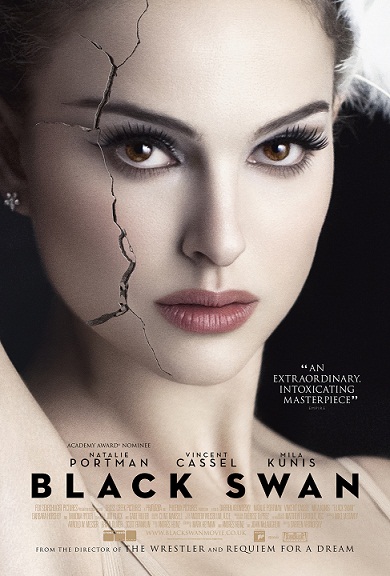Welcome, welcome.
Received a strange knock on my afternoon door earlier this week, followed by the sound of something hitting the wood floor in the hallway and hurried footsteps fading down the stairs. Opening the door, a large white envelope stared up at me, the unblinking red postmark stamp as omniscient as the eye of Solomon.
I grabbed the package, closed the door and locked it. The new Black Swan DVD had arrived.

Darren Aronofsky’s tale-within-a-tale, Black Swan was one of last year’s best films. Many are familiar with the Oscar-nominated flick’s re-telling of the Swan Lake ballet to create a psychological horror film that explores the perils of artistic perfection.
The movie has rightly earned it’s place among genre classics like Rosemary’s Baby and Carrie and – like the former – Black Swan is rife with occult symbolism and references that add weight to the scary-movie-cliches, making this bloody ballet one of those unique films that define a genre at the same time that it transcends the limits of that genre’s conventions.
Twins/Double
Of course, the central symbol of the film is the heroine’s (Nina – played by Natalie Portman) gradual crack-up into two separate personalities. This mental breakdown reflects the ballet’s protagonist/antagonist duality embodied by the White Swan and the Black Swan. Traditionally, these characters are portrayed by the same dancer and while Nina is the right dancer for the White Swan her attempts to embody the Black Swan are where her troubles begin.
In ancient Egypt, the twin rivals Horus and Set embodied the primal duality, and twin symbolism has long been associated with all occurrences of opposites – sun and moon, night and day, summer and winter etc. The good folks at hermetic.com offer this list of contrasts between Egypt’s Terrible Twins:
Horus |
Set |
| Day | Night |
| Life | Death |
| Fire | Water |
| Slayer | Slain |
| Bursting-forth of life | Withdrawal of life and its reappearance later |
| Openly active | Secretive |
| Conqueror & King | Victim & Rebel |
| Hawk, Lion, & Ram | Serpent, Antelope, Hippo |
| Rises into the sky | Descends into the Earth |
| Steals Set’s virility | Throws filth in face of Horus |
Often, another kind of twin symbolism emphasizes the balancing aspect of opposites. The caduceus staff with its entwining snakes has come to represent bothe the Greek god Hermes and the Roman god Mercury, but is thought by some to have originally been a representation – in and of itself – of a more ancient deity. Borrowed by alchemy, the symbol of the crucified serpent became synonymous with the Philosopher’s Stone and poet John Donne referred to Jesus Christ as the crucified serpent.
In Black Swan, the twin symbolism is strictly played antagonistically between the White Swan/Black Swan, Good Nina/Evil Nina, between Nina and a newly-added rival dancer in the company who lacks Nina’s expertise but oozes the sexuality and liberation that Nina cannot seem to summon.
Mirrors
Throughout the film, Aronofsky uses mirrors and reflections to further emphasize Nina’s gradual splitting into two distinct personalities. In some ways this is a technique that simply reinforces the twins theme, but the symbolism of mirrors and reflections has its own specific implications.
Mirrors have long been used in the occult for magical work and the twin-creating power of mirrors is reinforced when one considers that mercury was once the preferred backing used to make glass reflective. Mirror magic has been used to divine the future, contact otherworldly beings/dimensions and – more to the point regarding Black Swan – to peer directly into the chaos of the subconscious mind.
Check out more at Disinfo.
Joe Nolan <3










